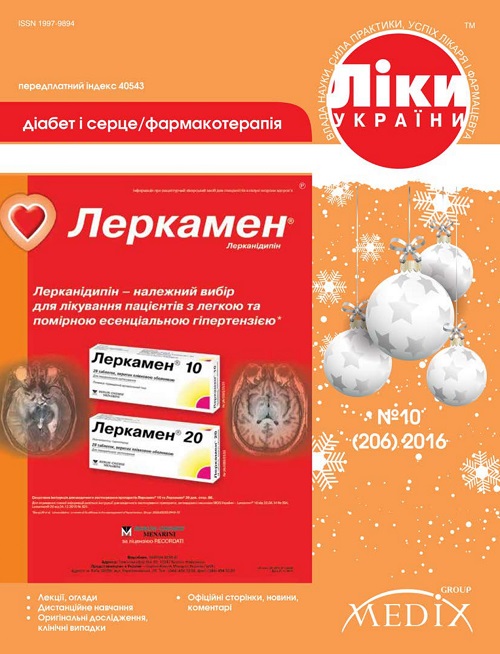Уратзнижуюча терапія при подагрі у практиці сімейного лікаря
DOI:
https://doi.org/10.37987/1997-9894.2016.10(206).207651Ключові слова:
подагра, подагричний артрит, уратзнижуюча терапія, алопуринол, фебуксостатАнотація
В оглядовій статті представлено сучасні рекомендації щодо ведення пацієнтів з подагрою та призначення уратзнижуючої терапії. Менеджмент подагри охоплює і об’єднує два напрями: по-перше, адекватне лікування гострих подагричних епізодів; по-друге, стійке зниження сироваткового рівня уратів нижче 360 мкмоль/л (6 мг/дл) або нижче, щоб запобігти рецидивам і сприяти розсмоктуванню тофусів. Представлено механізми дії різних класів уратзнижуючих препаратів, рекомендовано дози та алгоритм їх призначення. Розглянуто питання нефротоксичності алопуринолу та дози препарату залежно від швидкості клубочкової фільтрації. Критеріями ефективності уратзнижуючої терапії є зниження рівня сечової кислоти до цільових значень, відсутність гострих нападів подагри та резорбція тофусів.
Посилання
Барскова В.Г., Ильина А.Е. Рациональные подходы к диагностике и лечению подагры (по материалам рекомендаций Европейской антиревматической лиги) // Клиницист. – 2010. – №1. – С. 78–82.
Барскова В.Г., Ильиных Е.В., Насонов Е.Л. Фебуксостат – новый препарат в терапии подагры // Научно-практическая ревматология. – 2011. – №2. – С. 52–58.
Головач І.Ю. Сучасна терапія подагри крізь призму ефективності і безпечності // Боль. Суставы. Позвоночник. – 2015. – №2 (18). – С. 37–43.
Елисеев М.С. Новые международные рекомендации по диагностике и лечению подагры // Научно-практическая ревматология. – 2014. – №2 (52). – С. 141–146.
Михневич Э.А. Гипоурикемическая терапия подагры // Здравоохранение. – 2012. – №6. – С. 42–47.
Becker M.A., Schumacher H.R. Jr, Wortmann R.L. et al. Febuxostat compared with allopurinol in patients with hyperuricemia and gout // N. Engl. J. Med. – 2005. – Vol. 353. – P. 2450–2461.
Ben-Chetrit E., Bergmann S., Sood R. Mechanism of the anti-inflammatory effect of colchicine in rheumatic diseases: a possible new outlook through microarray analysis // Rheumatology. – 2006. – Vol. 45 (3). – P. 274.
Chao J., Terkeltaub R. A critical reappraisal of allopurinol dosing, safety, and efficacy for hyperuricemia in gout // Curr. Rheumatol. Rep. – 2009. – Vol. 11 (2). – P. 135–140.
Chiu M., Hu M., Ng M. et al. Association between HLA-B*58:01 allele and severe cutaneous adverse reactions with allopurinol in Han Chinese in Hong Kong // Br. J. Dermatol. – 2012. – Vol. 167. – P. 44–49.
Edwards N.L., So A. Emerging therapies for gout // Rheum. Dis. Clin. North Am. – 2014. – Vol. 40 (2). – P. 375–387.
Gliozzi M., Malara N., Muscoli S., Mollace V. The treatment of hyperuricemia // Inter. J. Cardiology. – 2016. – Vol. 213. – P. 23–27.
Hershfield M.S., Callaghan J.T., Tassaneeyakul W. et al. Clinical Pharmacogenetics Implementation Consortium guidelines for human leukocyte antigen-B genotype and allopurinol dosing // Clin. Pharmacol. Ther. – 2013. – Vol. 93. – P. 153–158.
Khanna D., Fitzgerald J.D., Khanna P.P. et al. 2012 American College of Rheumatology guidelines for management of gout. Part 1: systematic nonpharmacologic and pharmacologic therapeutic approaches to hyperuricemia // Arthritis Care Res. – 2012. – Vol. 64 (10). – P. 1431–1446.
Mandell B.F., Edwards N.L., Sundy J.S. et al. Preventing and treating acute gout attacks across the clinical spectrum: a roundtable discussion // Clevel. Clin. J. Med. – 2010. – Vol. 77 (Suppl. 2). – S2–25.
McLean L., Becker M.A. The pathogenesis of gout /Rheumatology Fourth Edition. Ed. by M.C. Hochberg, A.J. Silman, J.S. Smolen et al. – Phyladelphia, 2008. – P. 1813–1827.
Perez Ruiz F., Calabozo M., Pijoan J.I. et al. Effect of urate-lowering therapy on the velocity of size reduction of tophi in chronic gout // Arthritis Rheum. – 2002. –Vol. 47 (4). – P. 356–360.
Reinders M.K., van Roon E.N., Jansen T.L. et al. Efficacy and tolerability of uratelowering drugs in gout: a randomised controlled trial of benzbromarone versus probenecid after failure of allopurinol // Ann. Rheum. Dis. – 2009. – Vol. 68 (1). – P. 51–56.
Seth R., Kydd A.S., Buchbinder R. et al. Allopurinol for chronic gout // Cochrane Database Syst. Rev. – 2014. – Vol. 14.– 10 p.
Sivera F., Andres M., Carmona L. Multinational evidence-based recommendations for the diagnosis and management of gout: integrating systematic literature review and expert opinion of a broad panel of rheumatologists in the 3e initiative // Ann. Rheum. Dis. – 2014. – Vol. 73 (2). – P. 328–335.
Stamp L. K. Safety Profile of Anti-gout Agents: An Update // Curr. Opin. Rheumatol. – 2014. – Vol. 26 (2).– P. 162–168.
Stamp L., Taylor W., Jones P. et al. Starting dose, but not maximum maintenance dose, is a risk factor for allopurinol hypersensitivity syndrome: a proposed safe starting dose of allopurinol // Arthritis Rheum. – 2012. – Vol. 64. – P. 2529–2536.
Sundy J., Baraf H., Yood R. et al. Efficacy and tolerability of pegloticase for the treatment of chronic gout in patients refractory to conventional treatment: two randomized controlled trials // J. Am. Med. Assoc. – 2011. – Vol. 306. – P. 711–720.
Terkeltaub R., Furst D., Bennett K. et al. High versus low dosing of oral colchicine for early acute gout flare // Arthritis Rheum. – 2010. – Vol. 62. – P. 1060–1068.
White W.B., Chohan S., Dabholkar A. et al. Cardiovascular safety of febuxostat and allopurinol in patients with gout and cardiovascular comorbidities // Am. Heart J. – 2012. – Vol. 164. – P. 14–20.
Zhang W., Doherty M., Bardin T. et al. EULAR evidence based recommendations for gout. Part II: Management. Report of a task force of the EULAR Standing Committee For International Clinical Studies Including Therapeutics (ESCISIT) // Ann. Rheum. Dis. – 2006. – Vol. 65 (10).– P. 1312–1324


